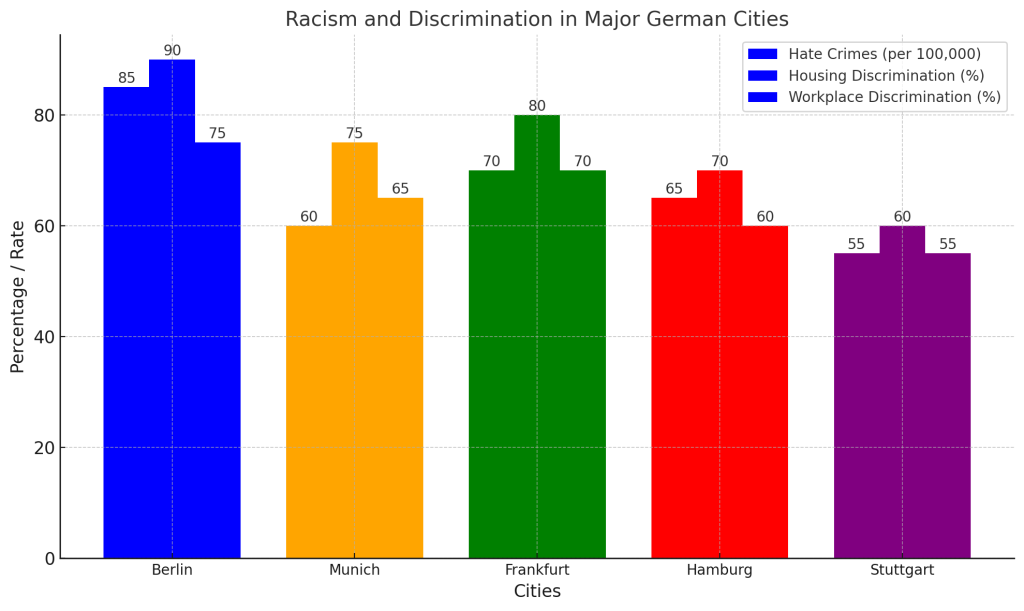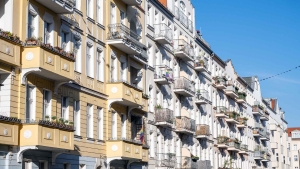Is Germany Racist? An Honest Look at Discrimination
Racism and discrimination are global issues, and Germany is no exception. While Germany is often praised for its progressiveness and strong legal frameworks protecting individual rights, the reality of racial and ethnic discrimination remains a persistent challenge in many aspects of daily life. This article examines whether racism exists in Germany, where it occurs, how it manifests, and the extent of its impact, drawing on official studies and scholarly research.
Racism in Germany: An Overview
- Racism in Germany: An Overview
- German Housing Market: A Barrier for Minorities
- Employment: Challenges in the Workplace
- Education and Schools: Discrimination from an Early Age
- Public Life and Everyday Interactions
- Universities: Racism in Higher Education
- How Much Racism Exists in Germany?
- Racism in Berlin: Germany’s Multicultural Capital
- Racism in Munich: A City of Contrasts
- Racism in Frankfurt: Financial Hub with a Diversity Problem
- Racism in Hamburg: A Port City Facing Challenges
- Racism in Stuttgart: A Growing Hub for International Workers
- Progress and Efforts to Combat Racism
- Comparing Germany, France, the UK, Italy, and Norway
- Germany: Progress Amid Challenges
- France: Legacy of Colonialism and Systemic Inequality
- United Kingdom: Diversity and Deep Divides
- Italy: Racism Amid Economic Struggles
- Norway: A Leader in Inclusivity?
- Comparative Analysis: Who’s Doing Better?
- Why These Differences Exist
Germany has made significant strides in addressing racism, particularly after its dark history during World War II. The country has established laws and institutions aimed at preventing discrimination, such as the General Equal Treatment Act (AGG), which prohibits discrimination based on race, ethnicity, gender, religion, disability, and more. Additionally, the Federal Anti-Discrimination Agency (ADS) provides support for victims and works to raise awareness about discriminatory practices.
Despite these measures, racism persists in various forms, ranging from subtle biases to overt acts of discrimination. Studies and surveys consistently show that racial minorities, immigrants, and people with foreign backgrounds experience unequal treatment in areas like housing, employment, education, and public life.
German Housing Market: A Barrier for Minorities
One of the most visible areas where racism manifests in Germany is the housing market. Discrimination often prevents individuals with non-German names or foreign backgrounds from securing rental agreements.
Studies and Findings
- Field Experiments: Research conducted by the Federal Anti-Discrimination Agency revealed that individuals with Turkish, Arabic, or African-sounding names were significantly less likely to receive positive responses from landlords compared to those with German names. For example, a study showed that “Ali” or “Fatima” often had to make twice as many inquiries to secure a viewing.
- Public Perception: Around 83% of respondents in a recent survey believe that racial discrimination is widespread in the housing market.
Real-Life Examples
Many immigrants report being turned away from rentals despite meeting all criteria. Some landlords explicitly prefer “German tenants,” perpetuating structural inequality.
Employment: Challenges in the Workplace
The job market is another area where discrimination is prevalent. While Germany is actively working to address labor shortages by recruiting international talent, biases against foreign applicants and employees remain significant obstacles.
Studies and Statistics
- Job Applications: Experiments show that candidates with foreign-sounding names are less likely to be invited to interviews, even when their qualifications are identical to those of German applicants.
- Workplace Discrimination: A survey by the ADS found that over 25% of employees reported experiencing or witnessing discrimination based on ethnicity or race at work.
Structural Barriers
Even when minorities are employed, they often face limited career advancement opportunities, pay gaps, and microaggressions from colleagues or supervisors. Foreign workers frequently report feeling undervalued compared to their German counterparts.
Education and Schools: Discrimination from an Early Age
Racism in Germany doesn’t only affect adults—it often starts in schools. For children from minority or immigrant families, education can become a space where biases and prejudices manifest.
Disparities in Education
- Teacher Bias: Research indicates that teachers may unconsciously grade students from minority backgrounds more harshly than their German peers.
- School Tracking: The German school system’s early tracking into vocational or academic pathways disproportionately places children from immigrant families into lower-tier schools, limiting their future opportunities.
- Bullying: Minority children frequently report facing racial bullying from classmates, which can hinder their academic performance and emotional well-being.
Public Life and Everyday Interactions
Discrimination in Germany extends beyond formal institutions and is often encountered in public spaces. Racial profiling, stereotyping, and verbal abuse are common experiences for people of color and those perceived as “foreign.”
Key Findings
- Racial Profiling: A 2020 study revealed that Black people and individuals of Middle Eastern descent are disproportionately stopped by police for identity checks.
- Verbal and Physical Abuse: Hate crimes against racial minorities, including anti-Muslim and anti-Semitic incidents, have been on the rise in recent years. In 2022, the Federal Ministry of the Interior recorded over 20,000 hate crimes, many of which were racially motivated.
- Access to Services: People with foreign backgrounds report being treated differently in restaurants, shops, and public offices, often experiencing poorer service or outright hostility.
Universities: Racism in Higher Education
Even in higher education, discrimination persists. Universities, which should ideally be bastions of inclusivity and diversity, are not immune to racial and ethnic biases.
Challenges Faced by Minority Students
- Representation: Students from immigrant families are underrepresented in higher education, partly due to systemic barriers in the earlier stages of education.
- Discrimination: International students frequently report feeling excluded or facing negative stereotypes, particularly those from Africa, the Middle East, or South Asia.
- Access to Opportunities: Minority students often face challenges in accessing internships, scholarships, and networking opportunities, which are critical for career advancement.
How Much Racism Exists in Germany?
Quantifying racism is challenging, but numerous studies provide insights into its prevalence:
- A 2021 report by the ADS found that 43% of discrimination complaints were related to race or ethnicity.
- A survey by Mediendienst Integration revealed that over 50% of respondents from minority backgrounds reported experiencing racism in the past year.
- The European Union Agency for Fundamental Rights (FRA) found that Germany ranks among the top EU countries where racial minorities report experiencing discrimination in daily life.
Racism in Berlin: Germany’s Multicultural Capital

Berlin is often celebrated as Germany’s most diverse city, home to a significant number of international students, expats, and foreign workers. Despite its reputation for inclusivity, racism remains an issue in various aspects of life.
Key Challenges
- Housing Discrimination: Foreigners often struggle to secure rental apartments due to biases from landlords. Studies show that individuals with Turkish or Arabic-sounding names are less likely to receive responses to housing inquiries.
- Public Spaces: Instances of racial profiling by law enforcement and reports of verbal abuse in public transport are common complaints.
- Employment: While Berlin is known for its thriving startup ecosystem, professionals from non-European backgrounds report facing challenges in accessing leadership roles or fair wages.
Racism in Munich: A City of Contrasts
Munich, with its high standard of living and strong economy, attracts many international professionals, particularly in the tech and automotive industries. However, the city’s traditional culture can sometimes make integration difficult for foreigners.
Key Challenges
- Workplace Racism: Some international employees report being excluded from workplace networks or passed over for promotions due to their ethnicity.
- Social Integration: The conservative social environment in Munich often makes it harder for people of color to feel fully accepted, even in diverse workplaces.
- Housing Market: As in Berlin, ethnic discrimination in the housing market is a significant issue, with many landlords preferring German tenants.
Racism in Frankfurt: Financial Hub with a Diversity Problem
Frankfurt is a global financial center with a large expat population. Its international vibe makes it attractive to foreign workers and students. However, discrimination remains prevalent in various areas.
Key Challenges
- Workplace Bias: In the financial sector, professionals from minority backgrounds often face subtle biases, such as microaggressions or assumptions about their capabilities.
- Education: International students in Frankfurt universities have reported incidents of exclusion and stereotyping by peers and faculty.
- Public Safety: Hate crimes and racially motivated verbal abuse in public spaces are occasionally reported, particularly targeting Black and Middle Eastern residents.
Racism in Hamburg: A Port City Facing Challenges
Hamburg is known for its cosmopolitan atmosphere and thriving trade industry, attracting students and professionals from around the world. Despite its global outlook, the city is not immune to racism.
Key Challenges
- Housing Discrimination: Foreign students and workers report difficulties in finding accommodation, with many landlords openly preferring German tenants.
- Public Transport: Reports of discriminatory behavior, such as passengers refusing to sit next to individuals of color, highlight underlying biases.
- Job Market: Non-German job seekers face barriers in accessing opportunities, especially in sectors dominated by traditional German firms.
Racism in Stuttgart: A Growing Hub for International Workers
Stuttgart is a magnet for foreign professionals, particularly in engineering and automotive industries. However, the city’s smaller size and less multicultural environment compared to Berlin or Frankfurt can make it more challenging for minorities.
Key Challenges
- Workplace Integration: Foreign professionals in Stuttgart often find it harder to break into social circles at work, with some reporting feeling isolated or undervalued.
- Educational Disparities: Children from immigrant families are often placed in lower-tier schools, reflecting systemic biases in educational institutions.
- Community Bias: Smaller communities within Stuttgart sometimes exhibit more overt racial prejudices compared to larger, more diverse cities.
Progress and Efforts to Combat Racism
Germany has made significant efforts to address racism and promote inclusivity:
- Government Initiatives: Programs like the National Action Plan Against Racism aim to tackle discrimination through education, policy changes, and public awareness campaigns.
- Anti-Discrimination Laws: The AGG provides a legal framework for victims to seek justice.
- Community Support: Numerous NGOs and advocacy groups work tirelessly to combat racism, support victims, and educate the public.
Despite these efforts, many experts argue that systemic racism requires more structural reforms and better enforcement of existing laws.
Comparing Germany, France, the UK, Italy, and Norway
Racism and discrimination are prevalent issues in many European countries, affecting housing, employment, education, and public life. This article examines how Germany, France, the UK, Italy, and Norway handle racism, comparing their strengths and weaknesses, and assessing which countries perform better and why.

Germany: Progress Amid Challenges
Germany has robust anti-discrimination laws like the General Equal Treatment Act (AGG) and institutions like the Federal Anti-Discrimination Agency (ADS). However, racism persists:
- Housing: Studies show that people with non-German names face significant bias from landlords.
- Public Spaces: Racial profiling by police and hate crimes, especially targeting minorities, remain issues.
- Strengths: Germany’s legal framework and public campaigns to combat racism show promise.
- Weaknesses: Persistent systemic bias in housing and employment limits progress.
France: Legacy of Colonialism and Systemic Inequality
France’s history of colonialism has left a legacy of racial and ethnic inequalities:
- Public Attitudes: Anti-immigrant sentiments are widespread, fueled by political rhetoric.
- Hate Crimes: Anti-Muslim and anti-Semitic incidents are alarmingly frequent.
- Strengths: Laws promoting secularism (laïcité) aim to ensure equality but often marginalize minorities.
- Weaknesses: Social and economic marginalization of immigrants from former colonies remains entrenched.
United Kingdom: Diversity and Deep Divides
The UK prides itself on multiculturalism, but racism is deeply rooted in society:
- Workplace: Studies show ethnic minorities face a “pay penalty,” earning significantly less than white colleagues.
- Hate Crimes: Post-Brexit, hate crimes, particularly anti-immigrant and Islamophobic attacks, have surged.
- Strengths: Public dialogue around racism is more open, and anti-racism movements are strong.
- Weaknesses: Institutional racism in policing and systemic inequality in housing and employment persist.
Italy: Racism Amid Economic Struggles
Italy’s approach to racism is less structured, with fewer formal protections for minorities:
- Housing and Jobs: Migrants from Africa and Eastern Europe face exclusion and exploitation.
- Public Safety: Hate crimes targeting refugees and ethnic minorities are frequent, often tied to far-right political rhetoric.
- Strengths: Grassroots organizations advocate for migrant rights.
- Weaknesses: Weak enforcement of anti-discrimination laws and limited resources for integration.
Norway: A Leader in Inclusivity?
Norway consistently ranks high in inclusivity but isn’t free from racism:
- Hate Crimes: Incidents are fewer compared to other countries, but Islamophobia and anti-Sámi discrimination persist.
- Social Policies: Proactive integration programs and strong anti-discrimination laws set Norway apart.
- Strengths: High public awareness and robust government policies promote equality.
- Weaknesses: Subtle biases still exist, particularly against non-European immigrants.
Comparative Analysis: Who’s Doing Better?
- Best Performers: Norway leads in combating racism through proactive policies, strong social safety nets, and low hate crime rates.
- Middle Ground: Germany and France perform similarly, with strong legal frameworks but persistent systemic issues.
- Worst Performers: Italy struggles the most due to weak enforcement of anti-discrimination laws and widespread social bias. The UK fares slightly better but is marred by institutional racism and hate crime surges.
Why These Differences Exist
- Policy and Enforcement: Countries like Norway benefit from strong enforcement of anti-discrimination laws, while Italy lacks resources to uphold its policies.
- Historical Context: Colonial histories in France, the UK, and Italy contribute to entrenched systemic racism.
- Public Awareness: Countries with higher public awareness, like Norway and the UK, tend to have stronger anti-racism movements.
- Economic Factors: Economic struggles in Italy exacerbate social tensions, while wealthier nations like Norway invest more in inclusivity.
How informative was this article?
Click on a star to rate it!
We are sorry that this post was not useful for you!
Let us improve this post!
What is missing in the article?















